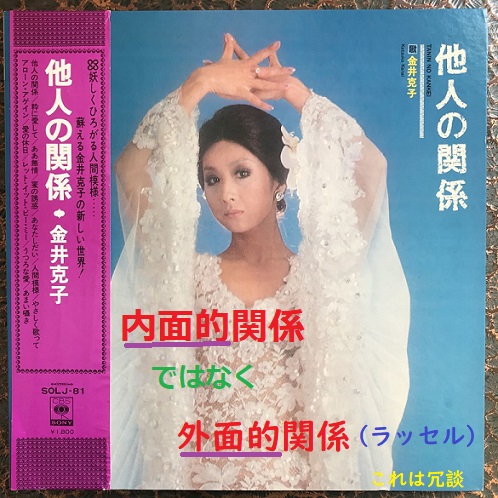
これら全ては、我々(ラッセルとホワイトヘッド)が『プリンキピア・マテマテカ』において展開した関係の算法(the calculus of relations)の哲学的背景であった。我々は,数学的論理学者(数理論理学者)が以前にははっきりとりあげなかった(make prominent)さまざまな概念を記号化するにいたった(was led to ~するように導かれた)。それらの中で、最も重要なものは以下のものである。(即ち) (1)与えられた項 y に対して関係Rをもつ項の集合、(2)与えられた項xが関係Rを持つ項の集合、(3)一つの関係の「領域」(domain)、即ち、何らかの項に対し関係Rを有する項の全ての集合で成り立っている「領域」、(4)Rの「逆領域」、即ち、なんらかの項が関係Rを有しているそれらの全ての項の集合(であるところの領域)、(5)Rの「範囲」(field)、即ち、領域と逆領域を両方あわせたもの、(6)関係Rの逆(関係)、即ち。Rがxとyの間に成り立つ時(hold 維持される)、yとxの間に成り立つ関係、(7)二つの関係RとSとの関係積(relative product)即ち、xとzとの間に中間項yがあり、xはyに対して関係Rをもち、yはzに対して関係Sをもつとき、xとzとの間に成り立つ関係、(8)複数(plurals)、これは次のように定義される。即ち、何らかの集合 a が与えられる時、a のいずれかの要素(メンバー)に対して関係Rを持つ全ての項の集合を我々が形成する(時に)与えられる(できあがる)何らかの集合 a。 これらの多様な概念を人間関係を考察することによって例示することが可能である。たとえば,Rが親と子との関係であるとしよう。すると(その時は)、(1)はyの両親である。(2)は子供たち(の集合)であり、(3)は子供を持つ全ての人々の集合であり、(4)は親をもつ全ての人々の集合、即ち、アダムとイブを除いた全ての人間である(訳注:聖書では、アダムは創造主が創ったもの、イブはアダムの肋骨から神が創造した女性。従って彼らは人間の両親をもっていない/ラッセルの冗談です)。(5)の親という関係の「範囲」は、誰かの親であるか誰かの子であるところの全ての人々からなっている(訳注:「親の範囲ではなく、親という関係の範囲であることに注意。親の範囲であれば集合の要素は親だけになる)。(6)「~の親」という関係の「逆」は「~の子」という関係である。(7)「祖父母」とは親と親との関係積(注:親の親)であり、「兄弟あるいは姉妹」とは「子」と「親」との関係積であり、「いとこあるいは兄弟あるいは姉妹」とは孫と祖父母との関係積であり、以下同様である。((8)「イートン校の生徒たちの親たち」は、この意味での「複数(形)」である。
Chapter 8 Principia Mathematica: Mathematical Aspects, n.4
All this was the philosophical background of the calculus of relations which we developed in the Principia. We were led to symbolize various concepts which mathematical logicians had not previously made prominent. Among these, the most important were: (1) the class of terms having relations R to a given term y ; (2) the class of terms to which a given term x has the relation R; (3) the ‘domain’ of a relation, which consists of the class of all those terms that have the relation R to something or other; (4) the ‘converse domain’ of R, which is the class of all those terms to which something or other has the relation R; (5) the ‘field’ of R, which consists of the ‘domain’ together with the ‘converse domain’; (6) the ‘converse’ of a relation R, which is the relation that holds between y and x whenever R holds between x and y ; (7) the ‘relative product’ of two relations R and S, which holds between x and z when there is an intermediate term y such that x has the relation R to y and y has the relation S to z; (8) plurals, defined as follows; given some class a we form the class of all the terms that have the relation R to some member of a. We can illustrate these various concepts by considering human relationships. Suppose, for example, that R is the relation of parent and child. Then (1) is the parents of y; (2) is the children of x-; (3) is the class of all those people who have children; (4) is the class of all those people who have parents – i.e. everybody except Adam and Eve; (5) the field of the relation ‘parent’ will consist of everybody who is either somebody’s parent or somebody’s child; (6) the converse of the relation ‘parent of’ is the relation ‘child of’; (7) ‘grandparent’ is the relative product of parent and parent, ‘brother or sister’ is the relative product of ‘child’ and ‘parent’, ‘first-cousin or brother or sister’ is the relative product of grandchild and grandparent, and so on; (8) ‘parents of Etonians’ is a plural in this sense.
Source: My Philosophical Development, chap. 8:1959.
More info.:https://russell-j.com/beginner/BR_MPD_08-040.HTM
